Catholic Customs
 |
 |
 |
 |
 |
 |
 |
The Carnival: Charming Customs,
Admiration for Royalty
The seasons of the Church are all well timed so that a period of penance and fasting is often preceded by a time of festivity. As humans,
we need joyous times and celebrations to make life bearable. Thus we find in times past the sufferings of the fasts and penance of Lent were traditionally eased by the period of Carnival before.
We find the first documentation of Carnevale in a charter dated 1094 signed by the Doge of St. Mark’s Cathedral, Vitale Faliero, in Venice. An illustrious start, since this is the man who miraculously found the body of St. Mark.
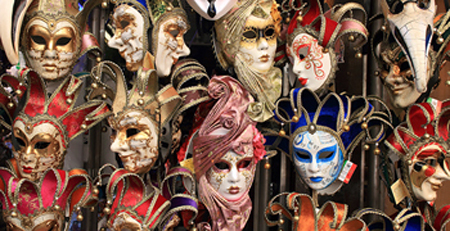 The festivities started to commemorate a Venetian victory under Doge Vitale Michieli over the Patriarch of Aquileia, Ulrich II. One of Venice’s best cities, Grado, had been captured and Doge Michieli regained it, capturing Ulrich II and 12 of his vassals.
The festivities started to commemorate a Venetian victory under Doge Vitale Michieli over the Patriarch of Aquileia, Ulrich II. One of Venice’s best cities, Grado, had been captured and Doge Michieli regained it, capturing Ulrich II and 12 of his vassals.
A condition for their release was made by the request of the Pope: The Aquileians were required to give a yearly tribute of one bull, 12 pigs, and 300 loaves of bread to the Republic of Venice. To celebrate that victory, the Venetians made a grand festival on Shrove Thursday where the tribute animals were slaughtered and eaten.
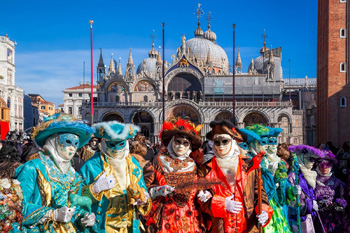
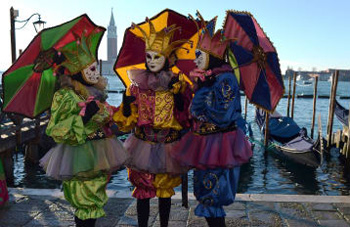 This celebration was the beginning of the marvelous costumes and masks that the Venetian people wore during their feasting and ceremonies; it was declared a public holiday by the Venetian Senate in 1296.
This celebration was the beginning of the marvelous costumes and masks that the Venetian people wore during their feasting and ceremonies; it was declared a public holiday by the Venetian Senate in 1296.
From Italy, the Carnival spread to Spain, Portugal and France; from there to the rest of Europe and to the New World wherever French and Spanish colonies existed (Louisiana, Canada, Latin America).
This period of festivity was to help people persevere through Lent, as Dom Guéranger notes in his Liturgical Year (vol. 4, p. 181-183). He praises the “original intention” of the “innocent custom.” At the same time he warns against leaving off the rigorous observance of the Church laws during the time of penance that was to follow.
Unfortunately, this warning was not heeded. By the time of the Renaissance, sensuality and frivolity had seeped into many Carnival celebrations, and at times Bishops found it necessary to ban them altogether in some place because of their abuses and immorality.
It almost goes without saying that, after the explosion of the 1960s sexual revolution, famous Carnival festivals like those in Rio and New Orleans changed to become a display of immodest dress (even outright nudity), rock music, drinking and partying. Good Catholics today should eschew these Carnival celebrations, which have become occasions of sin.
However, there are many charming customs of the Carnival season that deserve praise and mention as part of our Catholic history. In an attempt to restore the true Catholic spirit of what that “innocent Carnival” of the past, I will describe some of these customs.
Organic growth & regional customs
Carnival is typically thought of as the time from Epiphany until Shrove Tuesday (the day before Ash Wednesday). This period became a time to have festivities and to eat food rich in eggs, fat and meat, all of which were forbidden then during the time of Lent. So we see a practical purpose as well to these feastings. Wasting food was unthinkable, and so housewives had a way to empty their larders of the forbidden foodstuff. In some countries it was even forbidden to have these items in the pantry during Lent.
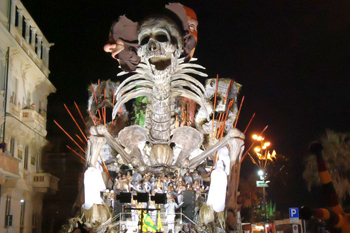 The central days of Carnival are the three days preceding Ash Wednesday, commonly known as Shrovetide. The term Shrovetide comes from the word shrive which means to confess, because it was on these days that the people went to confession to clean their souls for Lent . The purpose of the days was to make oneself pure and ready for Lent.
The central days of Carnival are the three days preceding Ash Wednesday, commonly known as Shrovetide. The term Shrovetide comes from the word shrive which means to confess, because it was on these days that the people went to confession to clean their souls for Lent . The purpose of the days was to make oneself pure and ready for Lent.
The Shrovetide traditions vary from country to country; each region and, sometimes, even each city adopted different ways of preparing the remaining forbidden foodstuff of Lent and of celebrating in mirth. These days were often characterized by the slaughtering of fattened pigs, lambs or calves depending on the region.
All celebrations of Catholic Carnival in the various countries had song, dance, marvelous costumes, parades, theatrical programs performed by men, horse and boat races and special food. The spirit of the people was reflected in the different and fantastic handmade masks worn by townspeople who portrayed various popular characters.
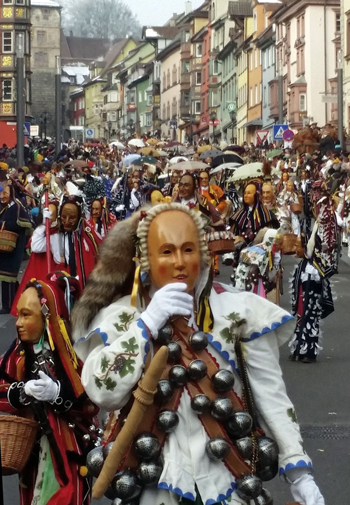 Nearly every Carnival celebration in every country had a figure who was the symbol of the season. In some places it was King Carnival; in others it was a jester. Every region and country have their own names and costumes for these characters. These characters, in effigy form, are typically burned at the end of Carnival, often after a mock trial and guilty verdict with elaborately dressed masked judges.
Nearly every Carnival celebration in every country had a figure who was the symbol of the season. In some places it was King Carnival; in others it was a jester. Every region and country have their own names and costumes for these characters. These characters, in effigy form, are typically burned at the end of Carnival, often after a mock trial and guilty verdict with elaborately dressed masked judges.
In Bearn, France, this ceremony is carefully detailed in Frederic Rivares's Chansons et Airs Populaires: “At a fixed hour, which has been loudly announced beforehand, a crowd of masks throng in a theatre prepared the previous day. The judges take their seats, the advocates are at their posts.
“The unhappy Carnival arrives on a cart drawn by an ass, surrounded by gendarmes, and most grotesquely dressed. He is lifted into his place; the accusation is made; the witnesses against him examined; he is defended by his lawyers, but in vain. He is condemned to an ingenious death. He is conducted to the bridge, when the president of the court executes the sentence he has himself pronounced, by setting fire to the defendant’s clothes, and precipitating him thus flaming into the river.”
Admiration for Royalty
Contrary to the revolutionary myth that the people despised the nobility, at Carnival we see the little people transforming themselves into Kings, Queens, Counts and Marquises in fantastical clothing and headgear.
From that grand menagerie, a Carnival King were often chosen. Each town had its unique ceremony to receive and honor their King with processions, speeches and theatrical displays. In Mainz, Germany, magnificently uniformed guards set up camp in the public square and became the bodyguards of King Carnival. Everything had an elegant and aristocratic tone.
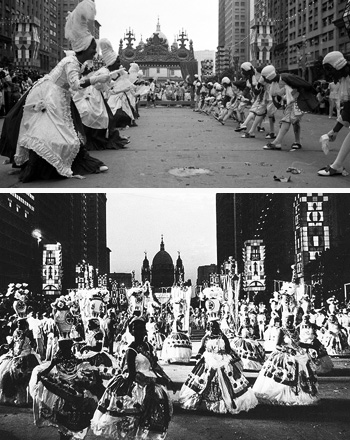 In Brazil, the common people processed in elaborate royal dress through the streets, a vivid sign of the people's love for the marvelous and admiration for the monarchy and aristocracy.
Commenting on the Brazilian Carnival of 1964, Dr. Plinio Corrêa de Oliveira notes:
In Brazil, the common people processed in elaborate royal dress through the streets, a vivid sign of the people's love for the marvelous and admiration for the monarchy and aristocracy.
Commenting on the Brazilian Carnival of 1964, Dr. Plinio Corrêa de Oliveira notes:
“Dressed as kings and queens in costumes and styles of the nobility and courtly pomp of bygone days, these members of the school of samba parade by, happy in evoking images from Brazil’s past. A well-known Rio magazine printed a most fitting title to an article covering the event: ‘Modest Workers and Simple Maidens Are Transformed into Kings, Princes, Counts, Queens and Marquises for a Night.’…
“Obviously, these costumes show no dull and scholarly fidelity to what was really worn in the time that they evoke. The popular imagination, rich in engendering the fabulous, present here the royalty and aristocracy as they imagine it. And the characteristic ‘charm’ of the Blacks adds an animated and delightful note to the assemblage.” (Catolicismo, July 1964)
Every region with its own Carnival style
One charming customs that endures to this day, although without the marvelous clothing, takes place in Ponti, Italy, where the town gathers in a grand festivalto make a giant dish of, polenta called Polentone.
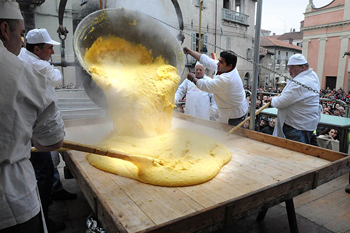
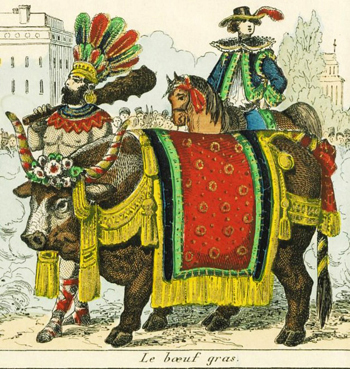 On the Friday before Lent, the men of the village gather on the streets to bake a huge polenta that weighs over a thousand pounds and a six thousand egg omelet. The ceremony for making these magnificent dishes is very elaborate with traditional song and a theatrical
display of a noble who rides into the square and speaks with a poor man, assuring him he will be richly fed soon. Here is a link to a charming video showing this ceremony.
On the Friday before Lent, the men of the village gather on the streets to bake a huge polenta that weighs over a thousand pounds and a six thousand egg omelet. The ceremony for making these magnificent dishes is very elaborate with traditional song and a theatrical
display of a noble who rides into the square and speaks with a poor man, assuring him he will be richly fed soon. Here is a link to a charming video showing this ceremony.
In Paris, there was a procession of the Boeuf Gras. A grand procession through the streets was led by the butchers of the city leading an ox decorated with flowers, followed by a splendid parade. A little boy who had been chosen to be “King of the Butchers” is enthroned on a richly decorated oxcart and applauded by all the people throwing flowers and confetti.
In Denmark and Norway, on the Monday before Ash Wednesday the children wake up early and go into their parent’s room with sticks beautifully decorated with paper flowers. The children then shout, “Give Buns” and the parents are sure to bring out Fastelavnsboller that they have made specially for this occasion lest they receive switches from their children.
In England, the church bells would ring on Shrove Tuesday reminding people to go to confession. These bells also sounded the signal to come to table for the special pancakes rich in butter and eggs. The bell became known not only as the “shriving bell” but as the “pancake bell.”
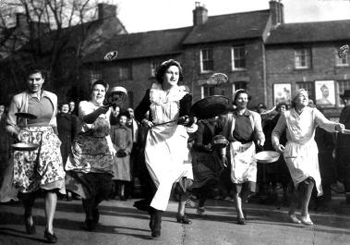 So integral is the pancake in the English Carnival celebrations that they hold pancake races on this day. According to legend, in 1445 a housewife was baking pancakes in her kitchen when she heard the shriving bell ring. She was in such a hurry that she ran out of the door and into the streets with her frying pan.
So integral is the pancake in the English Carnival celebrations that they hold pancake races on this day. According to legend, in 1445 a housewife was baking pancakes in her kitchen when she heard the shriving bell ring. She was in such a hurry that she ran out of the door and into the streets with her frying pan.
This inspired pancake races all over England, but especially in Olney where the women of the village gather to have a race where they run to the finishing line flipping the pancakes at least three times.
While the English made pancakes to use up their eggs and butter, the French made crepes, the Irish Boxty cakes (potato pancakes) with special trinkets inside, and the Russians Blini (buckwheat pancakes). In Italy, Germany and Poland special doughnuts dedicated to Carnival were made. It is interesting to see how different peoples made such a variety of foods using the same ingredients, thus reflecting how an organic society inspires each village to express its people in a variety of ways.
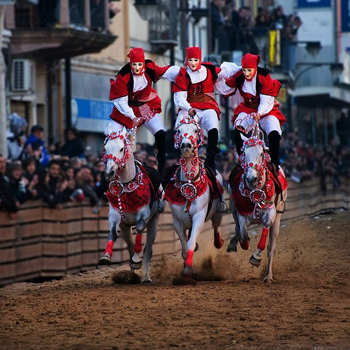 Shrove Tuesday should be a day of innocent celebration as it always was in the Catholic world. Obviously we cannot participate in the immoral and revolutionary public celebrations that constitute the modern Carnival. But why not introduce some innocent and marvelous celebrations in your family or community to provide a jovial festivity before the rigors of Lent.
Shrove Tuesday should be a day of innocent celebration as it always was in the Catholic world. Obviously we cannot participate in the immoral and revolutionary public celebrations that constitute the modern Carnival. But why not introduce some innocent and marvelous celebrations in your family or community to provide a jovial festivity before the rigors of Lent.
This helps to break the Puritanical spirit that is assumed in some American traditionalist communities. Children and adults alike have a longing for the marvelous, for the simple joys of life. Such good clean fun helps us to better practice a fervent Lent. Carnival celebrations can include folk dancing, singing lively folk songs, eating traditional doughnuts or pancakes according to the customs of your nationality, and dressing in magnificent costumes that inspire marvel and admiration for hierarchy and royalty.
Carnival was always taken seriously in the Middle Ages with work being suspended and the whole town participating in the public celebrations. At midnight, however, the partying would stop. Maria Von Trapp recalls the custom in Austria in which everyone would kneel down at midnight and recite the “Our Father.” After this prayer, everyone would rise and wish each other a blessed season of Lent before departing home to prepare for Ash Wednesday.
What a beautiful way to close the Carnival festivities and to instill the somber spirit of Lent where Catholics take up their self-imposed cross and prepare themselves to follow Our Lord to Calvary.

We find the first documentation of Carnevale in a charter dated 1094 signed by the Doge of St. Mark’s Cathedral, Vitale Faliero, in Venice. An illustrious start, since this is the man who miraculously found the body of St. Mark.

The colorful Carnival masks of Venice
A condition for their release was made by the request of the Pope: The Aquileians were required to give a yearly tribute of one bull, 12 pigs, and 300 loaves of bread to the Republic of Venice. To celebrate that victory, the Venetians made a grand festival on Shrove Thursday where the tribute animals were slaughtered and eaten.

Still today we find the expressive Venetian spirit displayed in the Carnival costumes and masks

From Italy, the Carnival spread to Spain, Portugal and France; from there to the rest of Europe and to the New World wherever French and Spanish colonies existed (Louisiana, Canada, Latin America).
This period of festivity was to help people persevere through Lent, as Dom Guéranger notes in his Liturgical Year (vol. 4, p. 181-183). He praises the “original intention” of the “innocent custom.” At the same time he warns against leaving off the rigorous observance of the Church laws during the time of penance that was to follow.
Unfortunately, this warning was not heeded. By the time of the Renaissance, sensuality and frivolity had seeped into many Carnival celebrations, and at times Bishops found it necessary to ban them altogether in some place because of their abuses and immorality.
It almost goes without saying that, after the explosion of the 1960s sexual revolution, famous Carnival festivals like those in Rio and New Orleans changed to become a display of immodest dress (even outright nudity), rock music, drinking and partying. Good Catholics today should eschew these Carnival celebrations, which have become occasions of sin.
However, there are many charming customs of the Carnival season that deserve praise and mention as part of our Catholic history. In an attempt to restore the true Catholic spirit of what that “innocent Carnival” of the past, I will describe some of these customs.
Organic growth & regional customs
Carnival is typically thought of as the time from Epiphany until Shrove Tuesday (the day before Ash Wednesday). This period became a time to have festivities and to eat food rich in eggs, fat and meat, all of which were forbidden then during the time of Lent. So we see a practical purpose as well to these feastings. Wasting food was unthinkable, and so housewives had a way to empty their larders of the forbidden foodstuff. In some countries it was even forbidden to have these items in the pantry during Lent.

The horrific and immorality are the new tones in the modern Carnivals
The Shrovetide traditions vary from country to country; each region and, sometimes, even each city adopted different ways of preparing the remaining forbidden foodstuff of Lent and of celebrating in mirth. These days were often characterized by the slaughtering of fattened pigs, lambs or calves depending on the region.
All celebrations of Catholic Carnival in the various countries had song, dance, marvelous costumes, parades, theatrical programs performed by men, horse and boat races and special food. The spirit of the people was reflected in the different and fantastic handmade masks worn by townspeople who portrayed various popular characters.

The Fools Procession in Rottweil, Germany
In Bearn, France, this ceremony is carefully detailed in Frederic Rivares's Chansons et Airs Populaires: “At a fixed hour, which has been loudly announced beforehand, a crowd of masks throng in a theatre prepared the previous day. The judges take their seats, the advocates are at their posts.
“The unhappy Carnival arrives on a cart drawn by an ass, surrounded by gendarmes, and most grotesquely dressed. He is lifted into his place; the accusation is made; the witnesses against him examined; he is defended by his lawyers, but in vain. He is condemned to an ingenious death. He is conducted to the bridge, when the president of the court executes the sentence he has himself pronounced, by setting fire to the defendant’s clothes, and precipitating him thus flaming into the river.”
Admiration for Royalty
Contrary to the revolutionary myth that the people despised the nobility, at Carnival we see the little people transforming themselves into Kings, Queens, Counts and Marquises in fantastical clothing and headgear.
From that grand menagerie, a Carnival King were often chosen. Each town had its unique ceremony to receive and honor their King with processions, speeches and theatrical displays. In Mainz, Germany, magnificently uniformed guards set up camp in the public square and became the bodyguards of King Carnival. Everything had an elegant and aristocratic tone.

Admiration for the royal dresses & dances is clearly seen in the '60s Rio de Janeiro Carnival
“Dressed as kings and queens in costumes and styles of the nobility and courtly pomp of bygone days, these members of the school of samba parade by, happy in evoking images from Brazil’s past. A well-known Rio magazine printed a most fitting title to an article covering the event: ‘Modest Workers and Simple Maidens Are Transformed into Kings, Princes, Counts, Queens and Marquises for a Night.’…
“Obviously, these costumes show no dull and scholarly fidelity to what was really worn in the time that they evoke. The popular imagination, rich in engendering the fabulous, present here the royalty and aristocracy as they imagine it. And the characteristic ‘charm’ of the Blacks adds an animated and delightful note to the assemblage.” (Catolicismo, July 1964)
Every region with its own Carnival style
One charming customs that endures to this day, although without the marvelous clothing, takes place in Ponti, Italy, where the town gathers in a grand festivalto make a giant dish of, polenta called Polentone.

The polentone is poured out of a huge caudron in Ponti, Italy; below, the Boeuf Gras procession in Paris

In Paris, there was a procession of the Boeuf Gras. A grand procession through the streets was led by the butchers of the city leading an ox decorated with flowers, followed by a splendid parade. A little boy who had been chosen to be “King of the Butchers” is enthroned on a richly decorated oxcart and applauded by all the people throwing flowers and confetti.
In Denmark and Norway, on the Monday before Ash Wednesday the children wake up early and go into their parent’s room with sticks beautifully decorated with paper flowers. The children then shout, “Give Buns” and the parents are sure to bring out Fastelavnsboller that they have made specially for this occasion lest they receive switches from their children.
In England, the church bells would ring on Shrove Tuesday reminding people to go to confession. These bells also sounded the signal to come to table for the special pancakes rich in butter and eggs. The bell became known not only as the “shriving bell” but as the “pancake bell.”

The pancake race in Olney, a village in England
This inspired pancake races all over England, but especially in Olney where the women of the village gather to have a race where they run to the finishing line flipping the pancakes at least three times.
While the English made pancakes to use up their eggs and butter, the French made crepes, the Irish Boxty cakes (potato pancakes) with special trinkets inside, and the Russians Blini (buckwheat pancakes). In Italy, Germany and Poland special doughnuts dedicated to Carnival were made. It is interesting to see how different peoples made such a variety of foods using the same ingredients, thus reflecting how an organic society inspires each village to express its people in a variety of ways.

The Carnival in Sartiglia, Italy, includes a horse race with daring feats
This helps to break the Puritanical spirit that is assumed in some American traditionalist communities. Children and adults alike have a longing for the marvelous, for the simple joys of life. Such good clean fun helps us to better practice a fervent Lent. Carnival celebrations can include folk dancing, singing lively folk songs, eating traditional doughnuts or pancakes according to the customs of your nationality, and dressing in magnificent costumes that inspire marvel and admiration for hierarchy and royalty.
Carnival was always taken seriously in the Middle Ages with work being suspended and the whole town participating in the public celebrations. At midnight, however, the partying would stop. Maria Von Trapp recalls the custom in Austria in which everyone would kneel down at midnight and recite the “Our Father.” After this prayer, everyone would rise and wish each other a blessed season of Lent before departing home to prepare for Ash Wednesday.
What a beautiful way to close the Carnival festivities and to instill the somber spirit of Lent where Catholics take up their self-imposed cross and prepare themselves to follow Our Lord to Calvary.


Posted February 24, 2020
______________________
______________________
 |
 |
 |
 |
 |
 |


